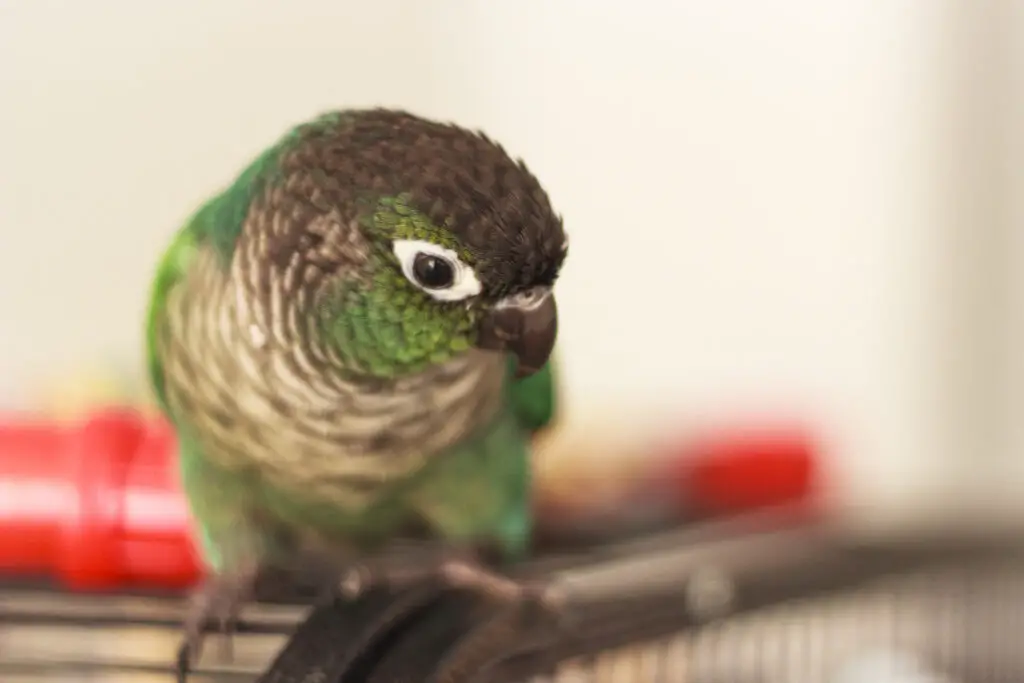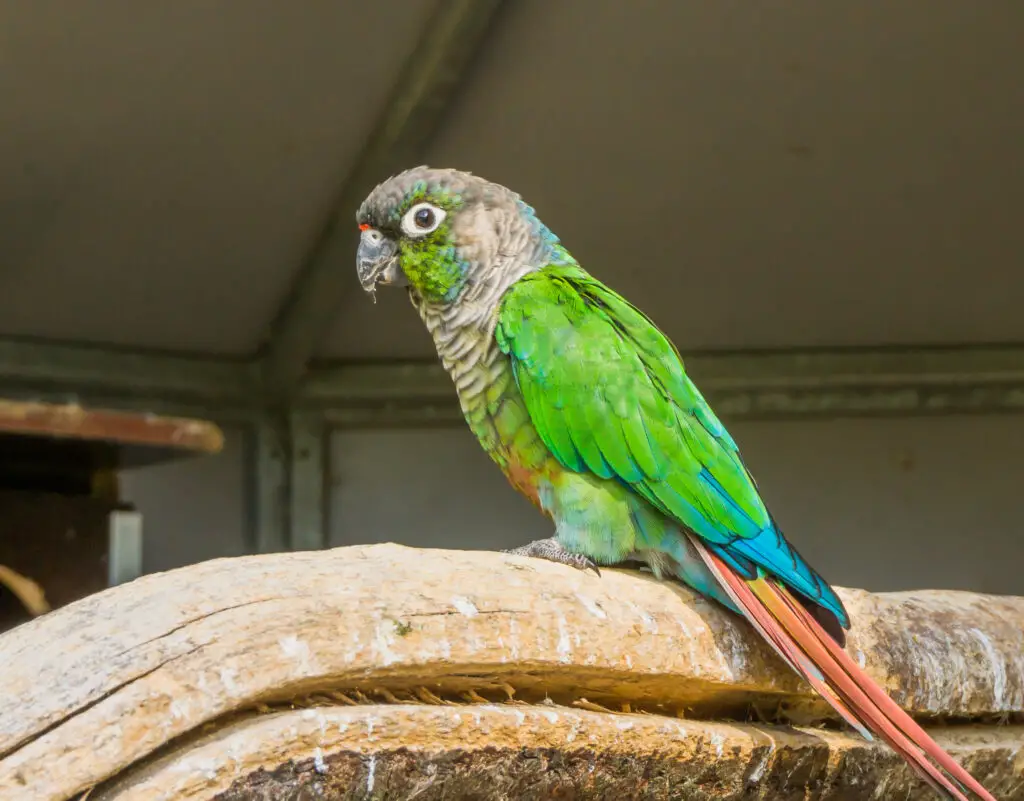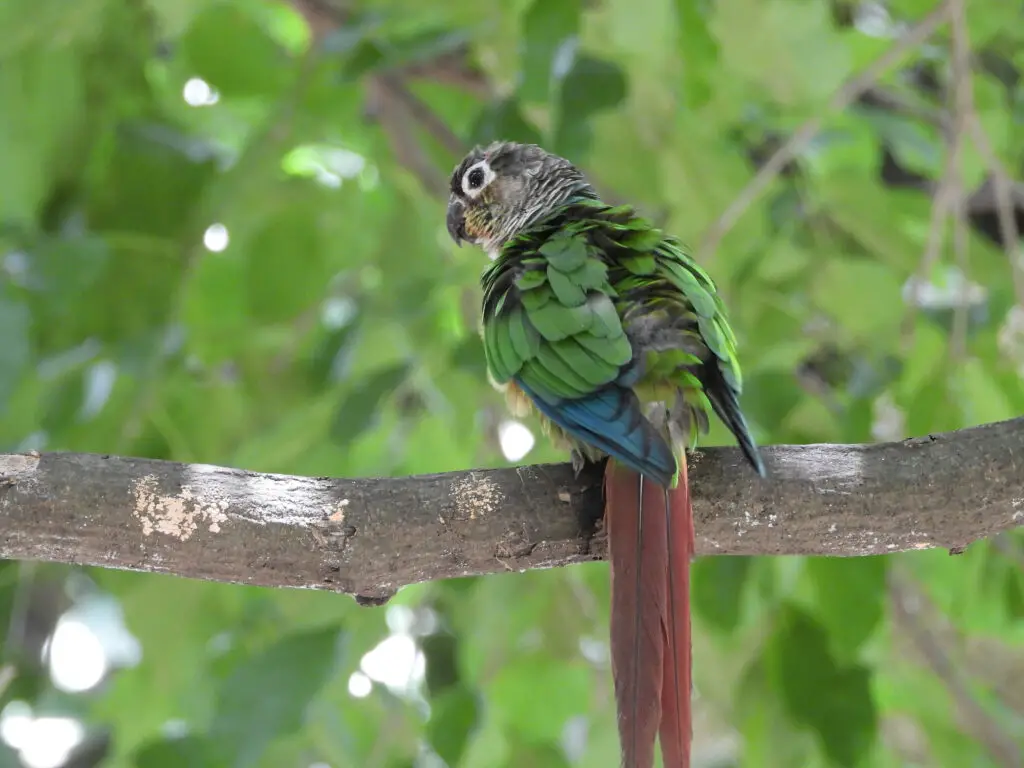Green cheek conures are one of the small birds you can adopt if you are looking for a family pet. These birds are small, so transitioning them into a new environment will be easy. However, taking care of this bird is not the only thing you must consider when adopting one.
True enough, you need to prepare your home when adopting a green cheek conure. That includes knowing the bird’s ideal environment, diet, and care requirements. But one thing most people fail to consider and prepare for when getting a green cheek conure for a pet is the length of time the bird will be with them. As a result, they end up releasing the bird or surrendering it to an adoption center once they realize how demanding it is.
That said, how long is a green cheek conure’s lifespan?
Key Takeaways
This article will discuss the following:
- The green cheek conure’s lifespan in captivity and the wild
- Factors that affect the lifespan of captive green cheek conures
- Factors that influence the lifespan of these birds in the wild
Green cheek conures can live for 15 years in the wild while about 30 years in captivity. Wild conures have a shorter lifespan as they are prey birds. Domesticated green conures can live longer as their caretakers provide all their diet, health, and recreational needs.
This article will tackle the factors that increase a green cheek conure’s lifespan in captivity. This way, you will learn how to keep your feathered companion in a healthy mental and physical condition.
Green Cheek Conure Lifespan

Parrots are famous for their long lifespan. You will be surprised that the oldest parrot, Cookie, a Major Mitchell’s cockatoo, lived from 1934 to 2016. According to the Guinness Book Of World Records, Cookie lived for 83 years and 58 days, making it the record for the oldest parrot.
Reportedly, a sulfur-crested cockatoo named Cocky Bennett was born in 1796 and died in 1916 at the age of 120.
Now that we have established the lifespans of different parrot species, let us talk about the green cheek conure’s lifespan.
How Long Can A Green Cheek Conure Live In The Wild?
According to the book Green Cheek Conure Training Guide, a green cheek conure can live for up to 15 years in the wild. These birds live in flocks as a way of protecting themselves from predators. As green cheek conures are small birds, they rely on numbers as their defense against danger.
You will commonly see them dwelling in treetops in the forests of:
- Bolivia
- Brazil
- Northern Argentina
- Paraguay
In addition, living on treetops reduces these birds’ chance of being prey. Green cheek conures mainly nest in tree holes. This way, larger predators cannot reach and harm them or their young. Despite their small size, these birds are large, so they use their screams to communicate with their flock.
But despite its tactics of avoiding dangers, green cheek conures are not safe from factors that can shorten their lifespan.
The most common reason why green cheek conures may live a short life in the wild is predators. Their predators include jaguars, monkeys, hawks, owls, eagles, and snakes. These predators can easily reach conures even if they are at the top of trees, so there is no place for the prey birds to keep themselves safe. Infections, injuries, and other health-related conditions also affect the green cheek conure’s lifespan in the wild.
How Long Do Green Cheek Conures Live In Captivity?
These birds live a much longer life in captivity. According to a thesis by Mackenzie Robinson, small conures, like the green cheek conure, can live for up to 30 years in captivity. This lifespan is double the bird’s lifespan in the wild for various reasons.
First, domesticated green cheek conures do not have any predators in captivity unless their caretaker has other pets, such as a cat or dog. But even in the presence of these predatory pets, conures can easily avoid dangers with the help of their caretakers.
Domesticated green cheek conures also have a constant supply of food and nutrients. So they do not have to fly to forage what they eat all day. For this reason, they can use most of their days to do something recreational and rest instead of exhausting themselves from hunting for food.
If a captive conure has an infection or illness, their caretakers bring them to a veterinarian. On the other hand, an ill wild conure will either heal on its own or die due to its illness.
Factors That Influence The Lifespan Of Domesticated Green Cheek Conures

Considering a domesticated green cheek conure’s lifespan, it is easy to tell that this bird has a better chance of survival in captivity. But while these birds can live for 30 years in captivity, their lifespan will still depend on their living condition.
That said, below are the factors that affect how long a domesticated green cheek conure can live:
Environment
The key to helping a green cheek conure live a long life in captivity is to keep it in a healthy environment. This bird is a messy eater, and its droppings easily make its enclosure dirty. A green cheek conure also tends to shred everything it gets its beak on.
A messy and unclean environment can harbor viruses, bacteria, and parasites, infecting and making your feathered friend sick. For instance, failing to remove leftover food from the bird’s cage can encourage mold growth, affecting its respiratory health. Having your conure live in such an environment is detrimental to its health and thus can decrease its lifespan.
For this reason, it is crucial to have tools that you can use to clean and sanitize a green cheek conure’s enclosure. Cleaning this bird’s cage once a week will make its environment comfortable and safe.
Diet
A healthy diet can undoubtedly increase a green cheek conure’s lifespan. Not only can feeding your pet nutritious food keep them healthy, but it will also keep them happy.
In captivity, a green cheek conure’s diet should consist mainly of specially formulated pellets. These pellets contain most of your feathered friend’s nutrient needs, thus supplying it with the vitamins and minerals that can keep it healthy. However, this bird’s diet should not only revolve around pellets.
Apart from special pellets, a green cheek conure should constantly supply fruits and vegetables. Giving this bird fresh fruit slices will give it the proper amount of sweet treats it needs. On the other hand, vegetables are a great source of fiber, which can help improve the conure’s gut health.
According to the study published in The Journal Of Nutrition, protein is essential for a conure to have a positive nitrogen balance. For this reason, it is essential to ask your bird’s veterinarian what its recommended protein intake is. This way, you can ensure that your feathered friend eats a balanced and nutritious diet.
Veterinary Visits
Parrots, like conures, are good at hiding illnesses. According to Patricia K. Anderson, hiding illnesses is a wild parrots’ survival instinct not to appear different, as looking weak will make them susceptible to predatory attacks. Domesticated green cheek conures also have this instinct.
For this reason, regularly bringing your feathered companion to an avian expert can ensure that it is always in good health. Apart from providing that your green cheek conure is healthy, the vet can also advise you on how to take care of it properly. They may even recommend some vitamins and supplements for your pet.
Mental Stimulation
Throughout the green cheek conure’s lifespan in the wild, it flies around to forage for food and shelter. This bird’s way of entertaining itself is to seek food and a place to live, along with interacting with its flock.
However, there is a limit on how much a domesticated conure can fly. It may not even have a companion bird to interact with. For this reason, providing your feathered companion with things to keep it occupied will help entertain it.
Some of the best mental stimulation for domesticated birds are toys, such as foraging toys, puzzles, stackable cups, and building blocks. But as green cheek conures are intelligent birds, they will get bored of their toys after some time.
So, apart from toys, physical activities are also essential. Lack of exercise can negatively impact your feathered companion, resulting in boredom, stress, and destructiveness. So, as a caretaker, you are responsible for providing them with mentally stimulating activities.
Training your green cheek conure is one of the best ways to help it become physically active. Ask your pet’s vet for training recommendations and implement them at home. Allowing your feathered companion to fly out of its cage regularly is also essential.
Early Detection Of Health Issues
While your green cheek conure will not show physical signs of weakness as long as it can, you can detect health issues early on by equipping yourself with knowledge about your pet. For instance, a change in your feathered companion’s feathers can indicate stress or infection.
Similarly, changes in the color and consistency of your pet’s droppings may say something about stomach health. These changes can also mean that your feathered companion suffers from a parasite.
By noticing these changes early on, you can provide your feathered companion with the treatment it needs. This way, you can potentially increase your green cheek conure’s lifespan.
Moreover, some of the early signs of health issues in domesticated green conure include:
- vomiting
- lack of energy
- wheezing
- discharge coming from the eyes and nostrils
- not eating or drinking
Factors That Decreases A Green Conure’s Lifespan In The Wild

As mentioned, a green conure’s lifespan in the wild is much shorter than its lifespan in captivity. Apart from predators, various factors influence how long this bird can live in the wild:
Lack Of Proper Nutrition
Wild green cheek conures feed on anything they can forage. For this reason, they suffer from an unbalanced diet and nutrition, as they have no supplemental feeding to improve their nutrient intake. Suppose a wild conure spends its energy flying and foraging for food but finds too little of it. In that case, it may experience weakness, making it a good target for predators. A wild green cheek conure’s lifespan may also shorten due to starvation.
Wild green conures usually feed on:
- berries
- grass seeds
- buds
- flowers
- fruits
- insects
While these food items are abundant in the wild, they may not contain the nutrients needed to support the conure’s health.
Illnesses And Injuries
As mentioned, diseases, infections, and parasites negatively impact the lifespan of wild green cheek conures. A wild conure may suffer from an easily-curable illness but pass away. The reason is that it will not be able to look for food due to its weakness.
While a wild conure may initially hide its illness and weakness, its declining health will soon be noticeable, causing predators to target it.
If a wild green cheek conure acquires an injury, it cannot look for food or get to treetops where it is safe from predators.
Green Cheek Conure Lifespan: Final Thoughts
Green cheek conures live differently in the wild than in captivity. Domesticated green cheek conures live in a safe environment. On the other hand, their wild counterparts live in an environment where many animals prey on them.
A wild green cheek conure’s lifespan can reach 15 years if it is lucky enough always to find food and escape predators. On the other hand, domesticated green cheek conures have their caretakers tending to all their needs to reach a lifespan of 30 years.
These Articles May Also Interest You:
- What Size Cage Is Needed For A Conure Parrot?
- 7 Reasons Why Conures Bite
- Can Conures Eat Pineapple? (We Find Out)
- The Costs Of Owning A Sun Conure Parrot
- Can A Conure Parrot Talk?
- A Guide To Breeding Sun Conure Parrots
- Conures and Molting: Everything You Need To Know
- When Do Conure Parrots Start Talking? Everything You Need To Know
- Can Conures Eat Watermelon? (We Find Out)
- What Is A Conure Parrot?
- Are Conures A Bird For Beginners? (Find Out Here)
- Are Conures Noisy? (The Truth Revealed)
- Guinness Book Of World Records. Oldest Bird. https://www.guinnessworldrecords.com/world-records/70977-oldest-bird. Accessed February 17, 2023.
- Robinson, Mackenzie. “Save The Flock: A Design Campaign Focused On Addressing Issues In The Exotic Bird Trade.” (2018). https://cardinalscholar.bsu.edu/bitstream/handle/123456789/201604/RobinsonMackenzie-combined.pdf?sequence=1&isAllowed=y. Accessed February 17, 2023.
- Austin Dennis. Green Cheek Conure Training Guide: The Essential Guide On Purchasing, Grooming, Feeding, Caring, Housing, Training, Health, And Tips On Raising Green Cheek. BookRix, 2023. https://books.google.com.ph/books?id=MpSrEAAAQBAJ&pg=PT21&dq=green+cheek+conure+lifespan+in+the+wild&hl=en&sa=X&ved=2ahUKEwilgZWH9539AhUAq1YBHfV5DfEQ6AF6BAgIEAI#v=onepage&q=green%20cheek%20conure%20lifespan%20in%20the%20wild&f=false. Accessed February 17, 2023.
- Carciofi, Aulus Cavalieri, José Maurício Barbanti Duarte, Deborah Mendes, and Luciana Domingues de Oliveira. “Food Selection And Digestibility In Yellow-Headed Conure (Aratinga Jandaya) And Golden-Caped Conure (Aratinga Auricapilla) In Captivity.” The Journal of nutrition 136, no. 7 (2006). doi: https://doi.org/10.1093/jn/136.7.2014S. Accessed February 17, 2023.
- Anderson, Patricia. “A Bird In The House: An Anthropological Perspective On Companion Parrots.” Society & Animals 11, no. 4 (2003). https://www.animalsandsociety.org/wp-content/uploads/2015/11/anderson.pdf. Accessed February 17, 2023.





